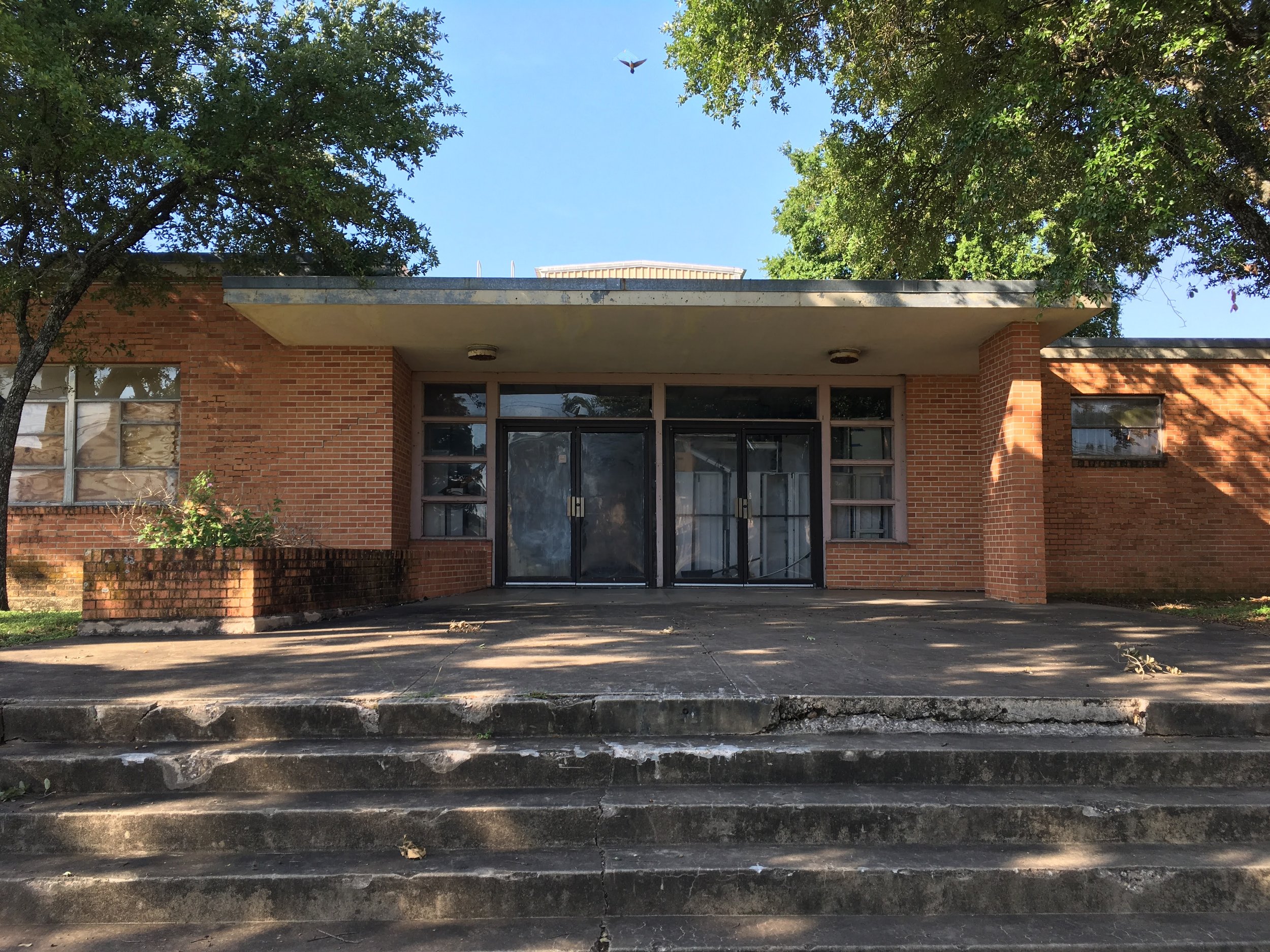Separate But Equal in Austin: L.C. Anderson High School
BY REBEKAH DOBRASKO
This article, originally published in the summer of 2017, is the first in a series of Preservation Austin newsletter articles about Old L.C. Anderson High School. Read our complete series here.
The former Anderson High School, main entrance, 2017
The old Anderson High School building sits atop a small hill at 900 Thompson Street in East Austin, just east of Pleasant Valley Road. This building, constructed in 1953, is the fourth to house L.C. Anderson High School, Austin’s only high school for African American students during the era of segregation. The school is not only significant as Austin’s historic black high school.
The building itself reflects the social context of the growing American population after World War II, the fight to maintain segregation in schools by building new black schools to be “separate but equal,” and national trends in school planning and school design. It is still owned by the Austin Independent School District (ASID), used as the district’s Alternative Learning Center and as the East Austin headquarters of the Boys and Girls Club. AISD’s recent facilities master planning process targets the old Anderson High School for redevelopment for new educational purpose. Preservation Austin intends to keep an eye on AISD’s plans for old Anderson, and is working with the alumni association and AISD to erect a historical marker at the school and to pursue other historic designations. The school is outside the boundaries of the city’s recent East Austin Historic Survey.
Anderson High at 1167 Comal, 1913
The first high school for Austin’s black students opened in 1889 in a small one-room building on the corner of San Marcos Street and East 11th Street. By 1908, the school district constructed a new frame high school on Olive Street. The third Anderson High School building, named after educators E.H. and L.C. Anderson, opened in 1913 on Pennsylvania Avenue and Comal Street.
The Olive Street school became an elementary school until it closed in the late 1940s due to declining enrollment and poor building conditions. That school later burned. The Comal Street school building became Kealing Junior High School when the “new” Anderson High School opened in 1953. That school building burned in the 1980s, although Kealing Middle School still remains at the site. The 1953 Anderson High School is one of only a few schools remaining to tell the story of black public education in the capital city.
The late 1940s and early 1950s were a time of great growth and change in Austin. Soldiers, both black and white, returned from fighting overseas and began settling down and starting families. AISD planned for new schools to accommodate student body growth . Austin needed new white high schools to serve the growing populations in the south (William B. Travis High), north (McCallum High), and west (O. Henry Junior High) sides of the city. However, since East Austin was the segregated portion of the city for African Americans, it planned for a larger black high school only in the east. At the same time, the National Association for the Advancement of Colored People (NAACP) began a sustained legal fight for equalization between black and white schools in the South. This legal fight quickly moved to an argument that segregation was, in fact, illegal. The NAACP unveiled this argument in Sweatt v. Painter, its landmark 1950 Supreme Court case to desegregate the University of Texas Law School.
Anderson High School cafeteria, 1955
Austin’s Negro Citizens Council pressured the AISD for better schools and better equipment. A study showed that Anderson High needed new buildings, improved lighting, lockers, bathrooms on each floor, and a larger cafeteria. Anderson High was the last AISD school to rely on coal for heating. One former teacher recalled her science classroom equipment: “an old Bunsen burner, some rocks, and a tuning fork.”
The school’s athletic fields were about ten blocks away from the school itself. As a result of the push to desegregate schools, white politicians and school districts across the South began upgrading and building new black schools. Historians call these “equalization” schools. The 1953 Anderson High School was an equalization school.
In 1948, AISD purchased a 22-acre site for a new Anderson High School designed by Austin architectural firm Kuehne, Brooks, and Barr. The new school had a modern design, with a flat roof, banks of aluminum windows that allowed light and air into the classrooms, and a modern heating system. The school had twenty-five classrooms, including spaces for art, music, science, home economics, business, and industrial classes. A new cafeteria held state-of-the-art food equipment, and a gymnasium and football field on the campus led to the 1953 Anderson campus becoming a true center of Austin’s African American community.
Y-Teens Club, 1955
Anderson High is significant as an intact example of the mid-century modern school. Schools similar in appearance to Anderson were built across Austin and across the nation. These were mostly built out of concrete and brick, as steel was still in short supply after World War II. AISD had to get federal Department of Education approval to use 273 tons of steel in Anderson High. Ultimately, Anderson High School cost a little less than $900,000 to build. It was expanded again by six classrooms in 1959.
Amid the new school planning swirled controversy over the segregation of students in the public school system. AISD and local officials were not blind to Sweatt v. Painter playing out in court. The courts directed states to equalize their schools or to admit black students. While these equalization and desegregation orders first occurred at the college level, local public school districts knew that elementary and secondary schools were next.
Science classroom, 1955
African American leadership in Texas prepared to file lawsuits demanding equalization. So, after decades of African Americans pushing for updated schools sufficient to hold all students, new equipment, new books, and amenities like cafeterias and gymnasiums, school districts were suddenly interested in providing these to the black community. As Lula Collins, alumni of Anderson noted,
“It was nice, it was new, and it was very accommodating because one of the things was to try and be sure that we were satisfied on this side, the east side, of East Avenue.” AISD built a new school for its black students, in the hopes that their parents would be satisfied and not push for actual integration.
Many were satisfied with the new Anderson High School. Alumni speak over and over about how the school was the center of the East Austin community. Teachers lived in the community, attended church alongside their students, and knew the parents. The school provided leadership opportunities for teachers, coaches, and administrators that were not available in Austin’s white schools. Everyone in East Austin attended the same high school, cheered for the same teams, and had the same traditions. Sporting events were community gathering places, and the school itself was used for plays, dances, lectures, and other community events.
The former Anderson High School gymnasium, 2017
In a place like Austin that segregated its black community to largely one location in the city, equalization had a chance of working. However, in 1954, the Supreme Court found in Brown v. Board of Education that segregation itself was unequal, and therefore unconstitutional. The AISD now faced the question of desegregating its school system. The desegregation story of Anderson High School played out across the South. In our next blog, we’ll learn about the closure of L.C. Anderson high school and its impact on East Austin’s African American community.
Rebekah Dobrasko is a public historian and volunteer with Preservation Austin and the Original L.C. Anderson Alumni Association. She has been telling the stories of the historic L.C. Anderson High School since 2017.
All historic images courtesy of the Austin History Center, current images courtesy of Rebekah Dobrasko.
Editor’s note: Anderson Stadium was listed on the National Register of Historic Places in February 2022. The successful nomination can be found here.






